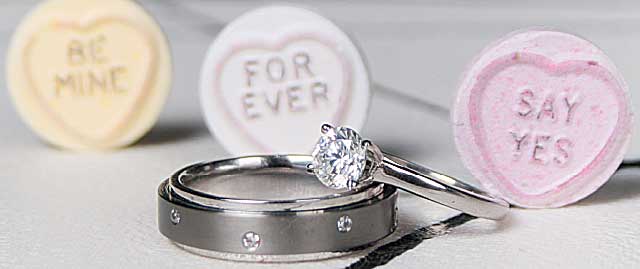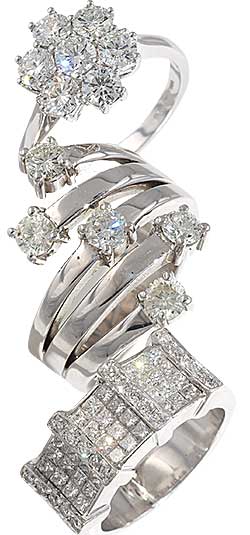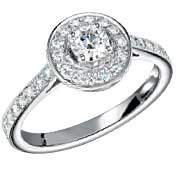
Words by Emma Langman [above: Tommy Nicoll Photography]
They’re the most significant reminder of your commitment, so it pays to pick your engagement ring and wedding bands carefully
The exchange of rings is one of the most symbolic moments in the wedding ceremony. Not only are they laden with meaning on the day, but thereafter they’ll be your constant companion, even when your spouse isn’t by your side. “Once the cake has been eaten and the hangovers have worn off, the rings will be one of the most important aspects from the day that you will wear for a very long time,” says Sarah Raffel at Brazen in Glasgow.


First off, consider which metal you would prefer for your set. Platinum, yellow, white and rose gold, and palladium are the most common options. Nowadays, yellow gold is often thought of as more old-fashioned while white metals like white gold and platinum remain the most popular choices. “White metals are very much in fashion. Platinum is the most precious of metals and is more than twice as durable as the second most popular, 18ct gold,” explains Grant Macintyre of John Macintyre & Son
While getting ‘his’ and ‘hers’ rings is a nice option, many men prefer chunkier-looking bands that lend themselves better to harder metals. “For gents’ wedding bands, palladium is the strong favourite. It shares similar properties with platinum and is naturally white, so doesn’t require replating like white gold,” explains Sarah Raffel. Your lifestyle is an important point to consider at this step in the process too, as more durable metals will suit outdoorsy types or people in manual work, for example.
After settling on your metal, it’s time to consider the setting and stones for your rings. If you’re finding it difficult to differentiate between your ‘paves’ and ‘princess cut’, don’t be afraid to ask your jeweller for advice. “The most popular of diamond cuts is ‘brilliant’ (or ‘princess’). It’s a modern diamond shape, like a square with untrimmed corners,” explains Grant Macintyre. You could also opt for something a little bit different like a stone with a heart-shaped, teardrop or emerald-shaped cut. These often need unusually-shaped engagement bands to work around them, so you may need a bespoke wedding ring to sit alongside. Jane Fleming at The Ringmaker explains, “If a perfect fit isn’t achieved, both rings could wear and damage can be expensive to repair. A perfectly fitting wedding band, made to a beautiful design, will enhance the engagement ring and give pleasure for a lifetime.” Made-to-measure options will usually take a number of weeks, so if you’re considering going down this route, start your search even earlier.
While many opt for a plain wedding band, when picking your stone for your engagement ring think about how you could match these up. Diamonds remain the most popular stone for both engagement and wedding bands, giving you a classic look that will never go out of fashion. As they come in a range of cuts, clarities and colours, they can fit into a range of budgets. There are other options out there, though, as Kate Middleton proved with her stunning sapphire ring. Try emeralds, rubies or even yellow diamonds for a more unusual look.
Your wedding rings also offer the chance to add a personal touch by incorporating family heirlooms. Jane Fleming advises, “If you have an heirloom ring it could be used together with new metal (which matches your engagement ring) to create a truly unique wedding ring of great sentimental value. In that one piece, you have something old and new for your wedding day.”
At Brazen, Sarah Raffel has come up with another unusual way of adding your family’s heritage into your own ring. “We can use ‘family gold’ to line the inside of wedding rings. I first did this for my sister when she was getting married. She brought me a ring from our mum and a ring from his mum. We then smelted the two down and lined both platinum rings on the inside. With a full high polish, they look fantastic when they’re off. When they’re on, it’s a nice personal touch and brings in a family tie using items that may well have lain in a box,” she explains.
Budget is a crucial consideration when it comes to your wedding rings, as their value can vary widely. Plain bands will generally have lower price points, while diamonds and coloured stones can take a bigger chunk out of your budget. Before you fall in love with that rock,
calculate how much you are able to spend. Most jewellers will be able to give you recommendations for the look and style you want at a price you can afford. “Have a budget and stick to it. Don’t look for something that is too fancy. You will wear it for a very long time, so you don’t want it to go out of fashion,” advises Grant Macintyre.
Above all, your rings should be a reflection of your taste and personality, so take your time and we’re sure yours will last a lifetime.
TRICKS OF THE TRADE


Lusting after a shiny rock but want to keep the price points down? Read on for some advice from the experts on how to make the most of your ring, whatever the budget
Engagement and wedding rings are one of the most special parts of your big day, but if you’re finding your wedding budget is already stretched a little bit too far, there are ways of making yours stand out without spending a fortune. At Laing the Jeweller, owner Michael Laing handpicks each of the diamonds they use to ensure his customers receive the highest levels of quality. He explains why: “Not all diamonds are equal in quality and value for money. Your diamond should be bursting with explosive use of light.
However it is easy to get side-tracked by a large stone that looks to be surprisingly good value compared to others, but turns out to be worth less than you paid for – a diamond which is poorly cut, tainted in colour or with critical imperfections, or, all three.” The cut of the diamond will play a part in how big it looks on the ring, as perfectly cut stones will look larger due to the play of light. “The world’s most perfectly cut diamonds are cut by ‘Hearts-on-Fire’ and they look bigger than other
diamonds of poorer cuts,” continues Michael.
As well as being considerate of your cut, check that the colour of your stone is as high as possible to get the most for your money. “Colour is what your eye picks up first and not the small naturally occurring marks in the stones, the majority of which can only be seen with a 10x magnification lens. Nice white stones will always look brighter even when slightly dirty,” advises bespoke ring specialist Alan P. Fulton.
The setting of your stone can also alter the visual effect, with the ability to enhance the look of your stone without affecting the cost too much. Alan P Fulton explains how: “You can make your engagement stone look bigger than it is by creating a mount that has a bit of finesse – not too chunky, and has an elegance to the height and shape of the setting and shoulders. The setting, in particular, should have a nice taper at the back – the claws should not be too vertical, as this can make the ring look clumpy and the stone look smaller. Creating the setting with a nice taper makes the setting look lighter and the stone bigger.”
Another insider secret is to choose your metal wisely, as some are better than others at making the most of your stone, but bear in mind these can require quite a lot of upkeep. “Some stones can look bigger because of highly polished white gold or platinum around the diamond. Unfortunately, as the metal gets rubbed and scratched in wear, metal dulls and spoils the effect,” says Michael Laing. But Alan P. Fulton has a solution to this problem: “If you are opting for white metal and your budget cannot stretch to platinum then palladium is a very good choice. It is a metal in the platinum family, is hypoallergenic (like platinum), and is a truly white metal too, while white gold is slightly yellow in colour and requires to be rhodium-plated. This rhodium plating wears off within six to 12 months and at the cost of re-plating over time can work out quite high,” he says.
(BSW:29)








